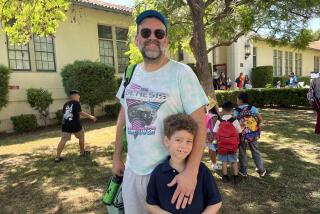No Sweet Deal : Teachers’ Trick Is to Deal With Students After Halloween
- Share via
On the day after Halloween, the trick was to overcome the treats as the 32 squealing kindergarten pupils bounded into Silvia Herranz’s classroom in Boyle Heights.
“They’re full of sugar,” Herranz shrugged. “They’re very hyper, very excited. Very hard to handle. We’ll play a lot of music and play a lot of games today.”
If Halloween is one of the sweetest nights of the year for children, some teachers say the morning after can be one of the sourest for them. Experts say sugar is not to blame, but teachers were taking their lumps Friday morning.
Kids who collected grocery bags full of Halloween candy come to class with their pockets crammed with M&Ms; and Tootsie Rolls. Those who stayed up late trick-or-treating and munching on candy are sluggish and drowsy.
“Kids are half falling asleep,” said Linda Serrano, librarian at Bridge Street School, where Herranz also teaches. “The first-graders’ heads were covering the table. They had a hard night last night.”
School nurse Norma Castro comforted several youngsters who complained of stomachaches from eating too much candy. One child had devoured so much that he became ill and had to be sent home.
They were having a hard morning across town in Cheviot Hills, too. Physical education teacher Peter Straus was having to prod his youngsters into exercising on the Castle Heights School playground.
“They’re coming down from a sugar high. Either they ate too much candy, or they stayed up too late last night. We’re having to jump-start them,” Straus said with a laugh.
Teachers say it’s easy to tie hyperactivity to sugar intake. Students who are dragging when recess rolls around return to class energized after they have popped a few Hershey’s Kisses or Gummi Bears into their mouths.
The experts say conventional wisdom is wrong, however. Sugar’s bad rap comes from mythology, not endocrinology.
“I don’t think it’s been documented there’s a relationship between sugar and hyperactivity,” said Carol Noelting, a registered dietitian and deputy director of food services for the Los Angeles Unified School District.
Dr. David A. Bluestone, a pediatrician from the Mid-Wilshire area, had a similar analysis.
“Children are more likely still experiencing the excitement from the night before,” he said. “That’s more likely than the sugar.”
But try telling that to Pam McGovern, a teacher at Western Avenue School in Southwest Los Angeles.
“I’m waiting for the sugar rush to hit,” McGovern said as she stepped before a room of second-graders to remind them once again to be sure to eat their dinner before diving into their trick-or-treat bags on Friday night.
Principal Linda Kim scheduled a day of special activities Friday as a way of slowing down those students. They included student-of-the-month awards in the morning and a special magic show in the afternoon.
The show was the kickoff for a school fund-raiser: a candy sale.
Although her 950 students had been instructed to leave their Halloween candy at home, there were a few slip-ups. When a boy with a big sucker sticking out of his mouth nodded to her in a hallway, Kim winced good-naturedly. “I didn’t see that,” she said.
Out on the playground, fifth-grader Patrice Lakey stepped up and offered Kim a piece of candy from a decorated Halloween box. When the principal gently reminded her of the rules, Patrice invoked her own version of the Twinkie Defense.
“Oops! I forgot!” the 10-year-old giggled.
Castle Heights pupil Morgan White, 5, sneaked in candy contraband to give to kindergarten teachers Joan Frosh and Jean Meltzer, who spent much of the day asking the children to sit still and “be good listeners.”
Classmate Michael Ovadya brought bubble gum for himself. “I chewed it, but nobody saw me,” the 5-year-old bragged. “I didn’t make any sounds.”
More to Read
Sign up for Essential California
The most important California stories and recommendations in your inbox every morning.
You may occasionally receive promotional content from the Los Angeles Times.














